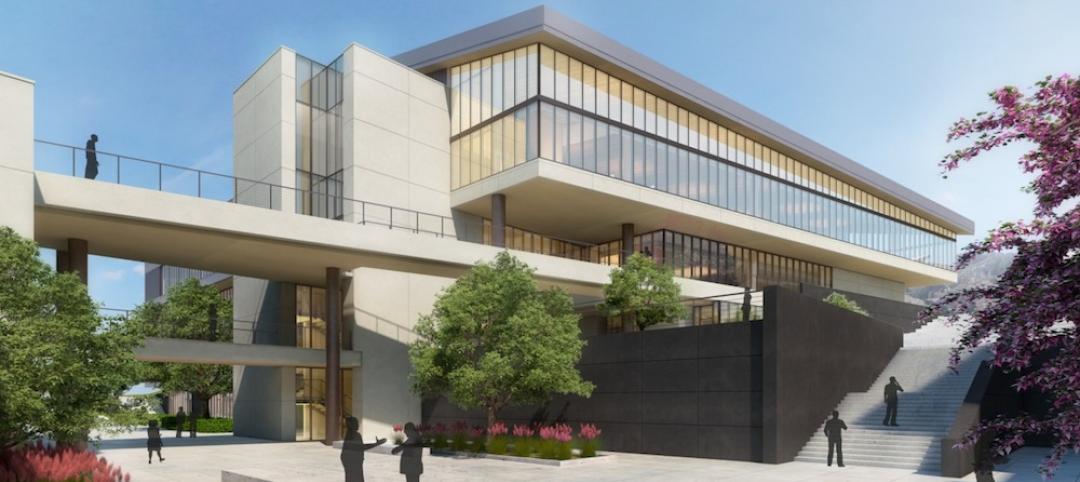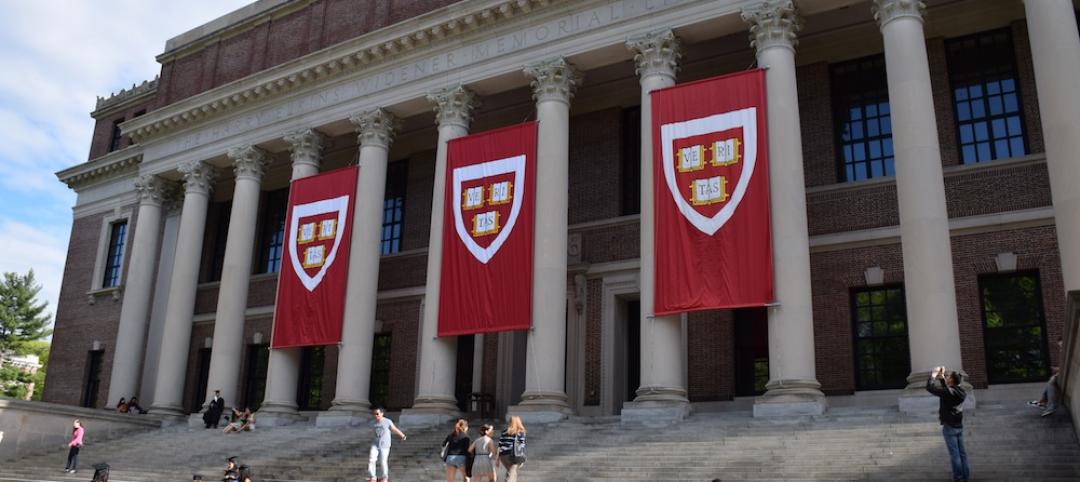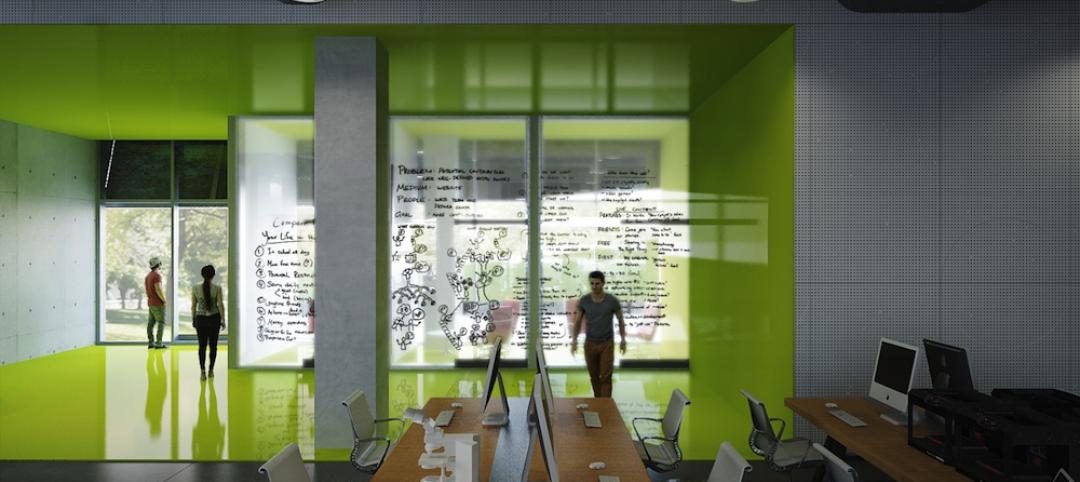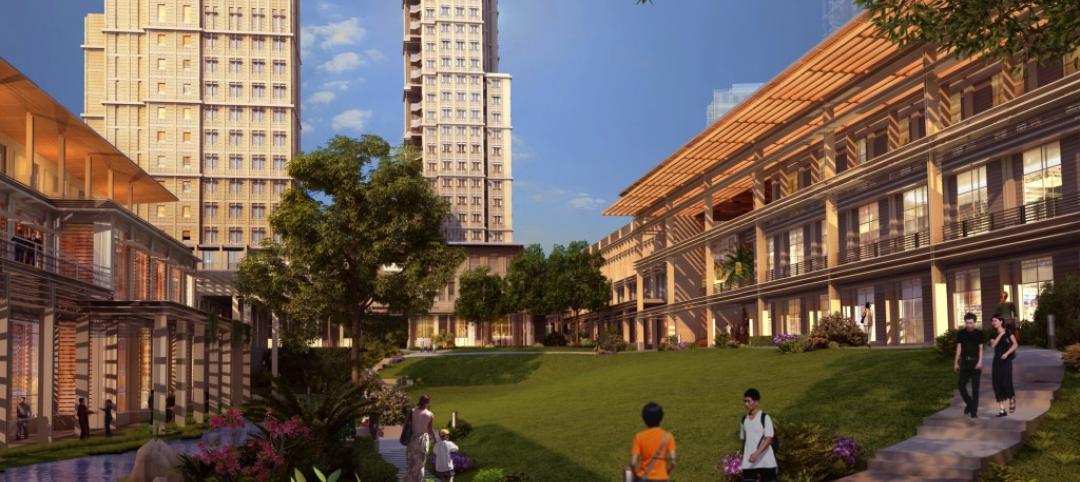On Monday, Columbia University held a dedication ceremony for its 17-acre Manhattanville campus in the West Harlem section of New York City. This $6.3 billion campus, which when completed will comprise 6.8 million sf of new academic space, is the university’s most ambitious expansion since it relocated to its current campus at Morningside Heights in Harlem 119 years ago.
The new campus, which was master planned by Skidmore Owings & Merrill and Renzo Piano Building Workshop, has been in the works since 2003, roughly around the time Lee C. Bollinger became the university’s president. “We knew that Columbia had to have new space to fulfill its mission as a great university,” said Bollinger during the dedication’s luncheon, held inside the 450,000-sf Jerome L. Greene Science Center, Manhattanville’s first building to open.
The Center, which should be fully occupied by next spring, is home to the Mortimer B. Zuckerman Mind Brain Behavior Institute. (The publisher and philanthropist Mort Zuckerman; Christina McInerney, president and CEO of the Jerome L. Greene Foundation; three Nobel Prize laureates and two Pulitzer Prize winners were among the dignitaries in attendance.)
Over the next two years, the Manhattanville campus will open the 60,000-sf Lenfest Center for the Arts, which will feature the Miriam and Ira D. Wallach Art Gallery, a 150-seat screening room, and a 4,300-sf presentation space; and the 56,000-sf University Forum, with a 430-seat auditorium.
Eric Kandel, MD, co-director of the Zuckerman Mind Brain Institute (and a Nobel Laureate in 2002 for the category physiology or medicine), proclaimed this project “historically important” to the university’s stature as well as for accentuating the symbiosis on campus between “bioscience and the arts.”
By 2021, the Ronald O. Perlman Center for Business Innovation and the Henry Kravis Building—492,000 sf across two buildings designed by Diller Scofidio + Renfro in collaboration with FXFowle Architects—will be the new home for the Columbia Business School.
Architect Renzo Piano describes the Jerome L. Greene Science Center in relation to its surrounding environment, which includes New York City's West Side Highway and the Hudson River. Image: BD+C
Architect Renzo Piano spoke at the dedication, at which he referred to the Jerome L. Greene Science Center as both a “palace” and a “factory that explores the secrets of the mind.” Piano also talked about the “urban layer” that will connect the campus to the community via reversed ground-floor setbacks, widened sidewalks, the absence of walls or gates (which is in marked contrast to the fortress-like Morningside Heights campus), height limitations (the Center is nine stories above ground), and a custom-glazed curtainwall.
His firm designed the Center to be as transparent as possible. The facility’s first floor, in fact, is open to the public. And its offices, labs, and other workspaces are organized on an open floor plan, divided into quadrants along North-South/East-West axes that expose workers and visitors to ample daylight.
Jerome L. Greene Science Center is across the street from an elevated subway line whose noise level measures 88 decibels. To mitigate that noise, the building was designed with a double-pane glass wall system whose 16-inch-wide air cavity in between exhausts air from the HVAC system and lets occupants open windows and glass doors from the inside. Open-air staircases connect the floors and encourage interaction between departments.
A 75,000-sf central energy plant, beneath the Greene and Lenfest buildings, will deliver electricity, chilled water, and high-pressure steam to nearly all of the buildings on campus.
The exterior bracing is visible to call attention to Greene’s “industrial” affinity with surrounding buildings in the neighborhood. That connection is reinforced by Columbia’s adaptive reuse of existing buildings on Manhattanville’s campus—specifically a one-time Studebaker auto-manufacturing plant and milk processing plant—that now serve, respectively, as university administration offices and Columbia’s center for the study of jazz and computer-generated music.
Manhattanville was the original name of this neighborhood, and Columbia and its AEC partners are at great pains to position this campus expansion as integral to a community that in the past has been wary about the university’s growth intentions. Bollinger, in his comments, went so far as to state that the new campus “is the best thing that could happen to upper Manhattan.”
Outdoor plazas within the campus will be accessible to the general public. The Jerome L. Greene Science Center will include a 1,920-sf Wellness Center that conducts free programs to raise awareness about stroke and related risk factors, and trains local residents to become community health workers. The Wellness Center will also be home to Mental Health First Aid, a program dedicated to improving the quality of mental health services in Upper Manhattan.
A 1,500-sf Education Lab within the Center will provide programs about brain science for the community and K-12 schools. Columbia has contracted with BioBus, an independent nonprofit, to run this program, and to bring learning into the community.
“This campus puts Columbia into the world,” observed Marilyn Jordan Taylor, a consulting partner with SOM (where she spent 33 years) and the former dean of the University of Pennsylvania’s School of Design.
Columbia|Manhattanville’s buildings are targeting LEED Platinum ND certification. Lendlease and McKissack Construction are the construction managers on the Greene and Lenfest buildings, Skanska and Velez Organization are the CMs on the University Forum building. And Turner will be the CM on the business school.
Related Stories
University Buildings | Mar 11, 2016
How architects can help community colleges promote community on campus
Even in the face of funding challenges and historic precedent, there are emerging examples of how partnership between two-year academic institutions and designers can further elevate community on campus. CannonDesign's Carisima Koenig has a few key examples.
University Buildings | Mar 1, 2016
The 5 most questionable college and university rankings of 2015
SmithGroupJJR's David Lantz identifies five of the most flawed higher education rating systems, including ones with arbitrary categories, and others that equate college with a transactional investment.
University Buildings | Feb 29, 2016
4 factors driving the student housing market
In the hyper-competitive higher education sector, colleges and universities view residence halls as extensions of their academic brands, both on and off campus.
University Buildings | Feb 17, 2016
New ideas to help universities attract and empower STEM students
Educational institutions are focusing on new learning strategies that engage students in activities, enable collaboration across STEM disciplines, and encourage students to use their hands just as much as their heads, as Stephen Blair of CannonDesign writes.
Multifamily Housing | Feb 1, 2016
Top 10 kitchen design trends for 2016
Charging stations, built-in coffeemakers, and pet stations—these are among the top kitchen design trends for the coming year, according to a new survey of kitchen and bath designers by the National Kitchen & Bath Association.
| Jan 14, 2016
How to succeed with EIFS: exterior insulation and finish systems
This AIA CES Discovery course discusses the six elements of an EIFS wall assembly; common EIFS failures and how to prevent them; and EIFS and sustainability.
Greenbuild Report | Dec 10, 2015
AASHE’s STARS tool highlights the university sector’s holistic approach to sustainability
Buzzwords like “living lab” and “experiential learning” are indicative of the trend toward more holistic sustainability programs that incorporate all facets of college life.
University Buildings | Nov 5, 2015
How active design is reshaping higher education campuses
Active design, a dynamic approach to design with a primary focus on people, assists students in learning to make healthy choices, writes LPA's Glenn Carels.
University Buildings | Nov 4, 2015
Yale completes Singapore campus
The Yale-NUS College has three residence halls and two administrative and academic buildings, with courtyards in the middle of them all.
University Buildings | Oct 16, 2015
5 ways architecture defines the university brand
People gravitate to brands for many reasons. Campus architecture and landscape are fundamental influences on the college brand, writes Perkins+Will's David Damon.

















